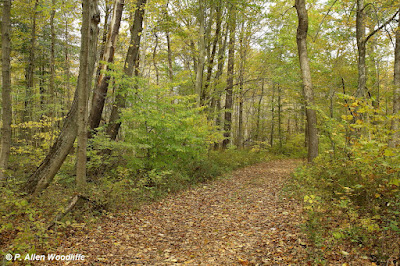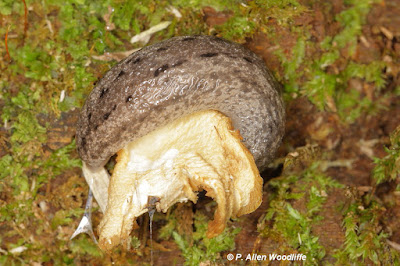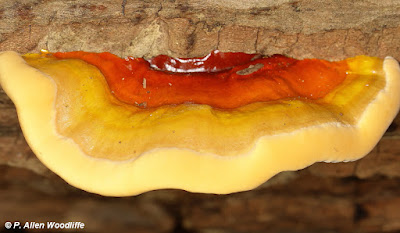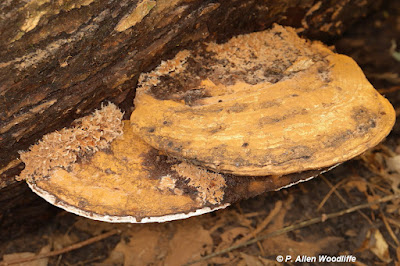This is the time of year when some of the more dramatic changes on the landscape occur. Late October through November is when the longest and strongest winds occur, and in combination with the continuing drop in temperature, the changes in forest vegetation are quite noticeable. As the chlorophyll in the leaves retreats up the stem, the normally less dominant colours of other elements in the leaves become visible. Red, yellow and orange will be more evident, until they turn brown, and then are blown off.
It is one of my most favourite times of year, even with the shorter day length to contend with. Natural areas are preparing for their winter senescence. Natural areas are less crowded, and one can enjoy the changes.
I've been out to Rondeau and elsewhere a few times over the last several days. Most recently it was on one of the windiest days of the fall to date, and with a predominant east wind. Walking the trails, shuffling through some of the fallen leaves, and listening to the waves roar is inspiring, at least to me. This photo of the east beach was taken this past Thursday.
I had decided to walk some of the inland roads and trail where it wasn't all that windy, but the roar of the waves was in high gear. Birds inland were not plentiful, but included the normal inhabitants: Red-bellied Woodpecker, Golden-crowned Kinglet, Black-capped Chickadee, etc. Perhaps if I had spent some of the time 'scoping the waterfront, I might have come across some of the uncommon species that others saw from nearby shorelines. Maybe next time.
The following photo was taken on Oct 28, showing a bit of change from the next photo, which was taken not quite three weeks earlier, on Oct 8. In some years, most of the leaves have already turned colour and/or fallen by now, but the warm, damp weather that has been the norm over the past few weeks has delayed that process. I expect much bigger changes in the next week or so.
As a further comparison, this next one was taken on Oct 26, 2015.
These next two were taken along Harrison Trail, the first one being on Oct 28 while the second one was taken in late September at almost the same vantage point.
This is normally the best time of year to find an endangered species: Red Mulberry. Red Mulberry is mainly limited in its Canadian range to places like southern Essex County (Pelee Island and Point Pelee NP), Rondeau and some parts of the Golden Horseshoe at the east end of Lake Erie. There are very few individuals elsewhere, but a few.
I hadn't been intentionally looking for them on this day, but always keep an eye open for them when the forest gets to this stage. I hadn't found any new ones in the last couple of years, so I was surprised to find not one, not two, but four and a half new ones! Yes, one was only a half a Red Mulberry in my opinion. While it showed very large leaves with some good drip tips, they were heavily lobed, as the next photo shows. Lobing does occur in Reds, but is more typical of the non-native White Mulberry, and there are quite a few Whites scattered around the park, especially on the east side. The lower leaves, also heavily lobed and much smaller, did not seem to have much in the way of pubescence on either the upper or lower surfaces, a sure sign of hybridization, although some of the pubescence may not be as evident as during the peak of the growing season. Most definitely I will have to take a closer look at this tree next year.
I also spent a bit of time at Erieau, as one never knows what might show up during the autumn migration. Perhaps the Harlequin Duck, scoters or Black-legged Kittiwake would make Erieau a rest stop. All of those have been here before. I didn't see any of those on this visit, but did encounter a small number of lingering Sanderling.
A Lesser Black-backed Gull, not a common, but regular species and probably about a third-cycle bird, was resting on the pier with the more abundant gull species.On the windiest day of my periodic visits to Erieau, I purposely went in order to capture some photos of the waves crashing over the pier. It was well worth the effort, but took care trying to shield my camera from the spray of water and sand.
Some of the wave sprays must have gotten as high as 10 metres or more above the pier. It was not a time to be venturing out on the pier! Some had done this many years ago, and came to a tragic end.
It isn't quite as dramatic as what Lake Superior must have been like when the Great Lakes freighter Edmund Fitzgerald went down to the bottom with all hands lost, but even this is certainly a demonstration of the power of moving water, and how it can shape the shoreline. Rondeau, as a sandspit peninsula, is all about such wind, wave and water currents that formed it over many centuries.
In some of my other travels of late, I came across a couple of new locations for Pawpaw. It is officially a Very Uncommon species in Ontario and Canada, although for some reason, Chatham-Kent has a significant segment of the overall population. These two clusters were fairly close together in the vicinity of Clear Creek Forest Provincial Park.
I also came across this rather large individual of Black Gum, another officially Very Uncommon species in Ontario and Canada. This is the only naturally occurring one that I know of in Chatham-Kent and is located a bit southeast of Thamesville. Using a clinometer, I measured it to be about 25 metres high. I didn't try and measure the diameter at breast height with my diameter tape, as the trunk was covered with many poison ivy vines, but I estimated it to be almost a metre in diameter. I had checked on this tree a couple of weeks ago, and although there was some nice deep red colour in the leaves, the sky was very bland, so I waited for a sunnier, brighter day. Alas, many of the leaves by this time had fallen off.Enjoy the autumn colours while they last!
If you would like to subscribe, or unsubscribe, to Nature Nuggets, send an email to prairietramper@gmail.com


















































































